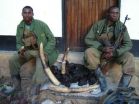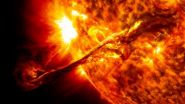(Press-News.org) DURHAM, N.H. – Although scientists involved in NASA's Van Allen Probes mission were confident they would eventually be able to rewrite the textbook on Earth's twin radiation belts, getting material for the new edition just two days after launch was surprising, momentous, and gratifying.
The Radiation Belt Storm Probes mission, subsequently renamed in honor of the belts' discoverer, astrophysicist James Van Allen, was launched in the pre-dawn hours of August 30, 2012. Shortly thereafter, and well ahead of schedule in normal operational protocol, mission scientists turned on the Relativistic Electron-Proton Telescope (REPT) to gather data in parallel with another, aging satellite that was poised to fall from orbit and reenter Earth's atmosphere. It was a fortuitous decision.
The telescope, which is part of the Energetic Particle, Composition, and Thermal Plasma (ECT) instrument suite led by the Space Science Center at the University of New Hampshire, immediately sent back data that at first confounded scientists but then provided a eureka moment: seen for the first time was a transient third radiation belt of high-energy particles formed in the wake of a powerful solar event that happened shortly after REPT began taking data.
"We watched in amazement as the outer radiation belt disappeared rapidly, but not completely; a small sliver of very energetic electrons remained at its inner edge, which we dubbed the 'storage ring,'" notes UNH astrophysicist Harlan Spence, principal investigator for the ECT suite and a co-author of a paper detailing the discovery published online today in the journal Science. "When the main outer electron belt reformed over subsequent days, it did so at a greater distance than where the storage ring was located, thus creating the transient, three-belt structure. The textbook was being rewritten right before our eyes."
Spence, director of the UNH Institute for the Study of Earth, Oceans, and Space, adds, "After decades of studying the radiation belts, this was a completely new phenomenon. With the Van Allen Probes' instruments we now have the 'eyes' capable of seeing such remarkable phenomena. We look forward eagerly to the rest of the mission in order to establish how often such extreme radiation belt structures and dynamics may occur."
The Van Allen belts are two donut-shaped regions of high-energy particles trapped by Earth's magnetic field. At the time of their discovery in 1958, they were thought to be relatively stable structures, but subsequent observations have shown they are dynamic and mysterious. However, this type of dynamic three-belt structure was never seen, or even considered, theoretically.
The identical twin satellites chase each other in a common orbit to achieve simultaneous spatial and temporal measurements of the radiation belt environment. The measurement of charged particles is key to the mission, with the ECT suite at the very heart of energetic electron measurements. The instrument suite has the capability to differentiate and precisely measure radiation belt particles on the fly—an extremely complex technical achievement, and necessary to push the science forward.
The suite's science goals address the top-level mission objective to provide understanding—ideally to the point of predictability—of how populations of electrons moving at nearly the speed of light and penetrating ions in space form or change in response to variable inputs of energy from the sun.
Says Spence, "These events we've recorded are extraordinary and are already allowing us to refine and confirm our theories of belt dynamics in a way that will lead to predictability of their behavior, which is important for understanding space weather and ultimately for the safety of astronauts and spacecraft that operate within such a hazardous region of geospace."
Notes Nicky Fox, Van Allen Probes deputy project scientist at The Johns Hopkins University Applied Physics Laboratory (APL) in Laurel, Md., "Even 55 years after their discovery, the Earth's radiation belts are still capable of surprising us, and still have mysteries to discover and explain. What the Van Allen Probes have shown is that the advances in technology and detection made by NASA have already had an almost immediate impact on basic science."
###
The Van Allen Probes project is the second mission in NASA's Living With a Star program to explore aspects of the connected sun-Earth system that directly affect life and society. APL built the probes and manages the mission. The program is managed by NASA Goddard. For more about the Van Allen Probes, visit: http://www.nasa.gov/vanallenprobes and http://vanallenprobes.jhuapl.edu/
For more on the Energetic Particle, Composition, and Thermal Plasma instrument suite visit: http://rbsp-ect.sr.unh.edu/team.shtml.
The University of New Hampshire, founded in 1866, is a world-class public research university with the feel of a New England liberal arts college. A land, sea, and space-grant university, UNH is the state's flagship public institution, enrolling 12,200 undergraduate and 2,300 graduate students.
Photograph to download: http://www.eos.unh.edu/newsimage/304Whip_lg.jpg
Caption: On Aug. 31, 2012, a giant prominence on the sun erupted, sending out particles and a shock wave that traveled near Earth. This event may have been one of the causes of a third radiation belt that appeared around Earth a few days later, a phenomenon that was observed for the very first time by the newly-launched Van Allen Probes. This image of the prominence before it erupted was captured by NASA's Solar Dynamics Observatory (SDO). Credit: NASA/SDO/AIA/Goddard Space Flight Center.
UNH principal investigator Harlan Spence can be reached at 781-439-7262 and Harlan.spence@unh.edu.
Third radiation belt discovered with UNH-led instrument suite
2013-03-01
ELSE PRESS RELEASES FROM THIS DATE:
Adult sleepwalking is serious condition that impacts health-related quality of life
2013-03-01
DARIEN, IL – A new study found that adult sleepwalking is a potentially serious condition that may induce violent behaviors and affect health-related quality of life.
"We found a higher frequency of daytime sleepiness, fatigue, insomnia, depressive and anxiety symptoms and altered quality of life in patients with sleepwalking compared to the control group," said Yves Dauvilliers, MD, PhD, the study's principal investigator and lead author. Dr. Dauvilliers is professor of physiology and neurology and director of the sleep lab at Gui-de-Chauliac Hospital in Montpellier, ...
Elephants are vanishing from DRC's best-run reserve
2013-03-01
NEW YORK (Feb. 28, 2013) — The Democratic Republic of Congo's (DRC) largest remaining forest elephant population, located in the Okapi Faunal Reserve (OFR), has declined by 37 percent in the last five years, with only 1,700 elephants now remaining, according to wildlife surveys by WCS and DRC officials. WCS scientists warn that if poaching of forest elephants in DRC continues unabated, the species could be nearly extinguished from Africa's second largest country within ten years.
According to the latest survey, 5,100, or 75 percent, of the reserve's elephants have been ...
New model could lead to improved treatment for early stage Alzheimer's
2013-03-01
GAINESVILLE, Fla. — Researchers at the University of Florida and The Johns Hopkins University have developed a line of genetically altered mice that model the earliest stages of Alzheimer's disease. This model may help scientists identify new therapies to provide relief to patients who are beginning to experience symptoms.
The researchers report their findings in the current issue of The Journal of Neuroscience.
"The development of this model could help scientists identify new ways to enhance brain function in patients in the early stages of the disease," said David ...
Research unearths new dinosaur species
2013-03-01
RAPID CITY, S.D. (Feb. 28, 2013) – A South Dakota School of Mines & Technology assistant professor and his team have discovered a new species of herbivorous dinosaur and published the first fossil evidence of prehistoric crocodyliforms feeding on small dinosaurs.
Research by Clint Boyd, Ph.D., provides the first definitive evidence that plant-eating baby ornithopod dinosaurs were a food of choice for the crocodyliform, a now extinct relative of the crocodile family. While conducting their research, the team also discovered that this dinosaur prey was a previously unrecognized ...
ACC/HRS release appropriate use criteria for ICDs and CRT
2013-03-01
WASHINGTON (Feb. 28, 2013) –The American College of Cardiology and the Heart Rhythm Society, along with key specialty societies, today released appropriate use criteria for implantable cardioverter-defibrillators (ICDs) and cardiac resynchronization therapy (CRT). The document provides assessed levels of appropriateness for implanting the devices in 369 real-life clinical scenarios, with the goal of enhancing physician and patient decision making and improving care and health outcomes.
Implantable cardioverter-defibrillators are devices that monitor the heart's rhythms ...
Sea lamprey genome mapped with help from scientists at OU
2013-03-01
Beginning in 2004, a group of scientists from around the globe, including two University of Oklahoma faculty members, set out to map the genome of the sea lamprey. The secrets of how this jawless vertebrate separated from the jawed vertebrates early in the evolutionary process will give insight to the ancestry of vertebrate characters and may help investigators more fully understand neurodegenerative diseases in humans.
David McCauley, associate professor in the Biology Department in the OU College of Arts and Sciences, and Sandra W. Clifton, with the OU Center for Advanced ...
Pour, shake and stir
2013-03-01
TORONTO, Ontario (Feb. 28, 2013) - A diagnostic "cocktail" containing a single drop of blood, a dribble of water, and a dose of DNA powder with gold particles could mean rapid diagnosis and treatment of the world's leading diseases in the near future. The cocktail diagnostic is a homegrown brew being developed by University of Toronto's Institute of Biomaterials and Biomedical Engineering (IBBME) PhD student Kyryl Zagorovsky and Professor Warren Chan that could change the way infectious diseases, from HPV and HIV to malaria, are diagnosed.
And it involves the same technology ...
NOAA and NASA's next generation weather satellite may provide earlier warnings
2013-03-01
A new satellite that will detect the lightning inside storm clouds may lead to valuable improvements in tornado detection. The GOES-R satellite is currently being built with new technology that may help provide earlier warnings for severe weather. The national average is a 14-minute lead time to warn residents of a tornado, but NASA and NOAA scientists are looking to improve severe weather detection to save lives and property. They are developing the Geostationary Operational Environmental Satellite-R Series, or GOES-R, to observe thunderstorm development with much greater ...
NASA's Van Allen Probes discover a surprise circling Earth
2013-03-01
After most NASA science spacecraft launches, researchers wait patiently for months as instruments on board are turned on one at a time, slowly ramped up to full power, and tested to make sure they work at full capacity. It's a rite of passage for any new satellite in space, and such a schedule was in place for the Van Allen Probes when they launched on Aug. 30, 2012, to study two giant belts of radiation that surround Earth.
But a group of scientists on the mission made a case for changing the plan. They asked that the Relativistic Electron Proton Telescope (REPT) be ...
Zeroing in on heart disease
2013-03-01
Studies screening the genome of hundreds of thousands of individuals (known as Genome-wide association studies or GWAS) have linked more than 100 regions in the genome to the risk of developing cardiovascular disease. Researchers from the European Molecular Biology Laboratory (EMBL) and the University of Heidelberg, through the joint Molecular Medicine Partnership Unit (MMPU), are taking these results one step further by pinpointing the exact genes that could have a role in the onset of the disease. Their findings are published today in the Public Library of Science (PLoS) ...



